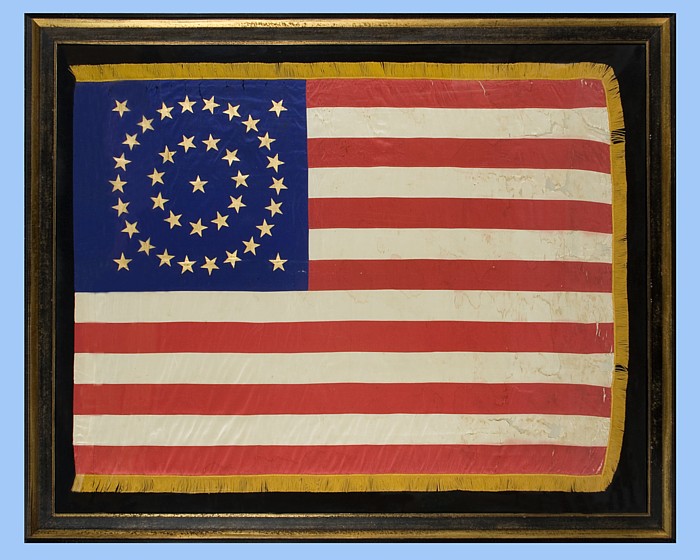
| |
38 STAR FLAG WITH GILT-PAINTED STARS IN A MEDALLION CONFIGURATION, AN INDIAN WARS ERA BATTLE FLAG, 1876-1889, COLORADO STATEHOOD, HAND-SEWN SILK WITH GOLD FRINGE |
|
| Available: |
Sold |
| Frame Size (H x L): |
Approx. 57" x 72.5" |
| Flag Size (H x L): |
46" x 61.5" |
|
| Description....: |
|
38 star American national flag, entirely hand-sewn of silk with beautiful, gilt-painted stars. These are arranged in what is known as a medallion configuration. This specific variation of the design, called a double-wreath, consists of a single center star, surrounded by two consecutive wreaths of stars, with a flanking star in each corner of the royal blue canton.
This is a small-scale military battle flag with an open sleeve at the hoist end so that it could be inserted directly into a large staff. Most infantry battle flags of the mid-late 19th century measure about 76" x 72" and thus were both very large and nearly square in their proportions. This example is unusual because of its small size. At just 46" x 61.5", the scale is both smaller and slightly more rectangular. Smaller flags are more desired by both one-time flag buyers and collectors alike, for the simple reason that they are so much easier to display. Flags were large in the 19th century because they needed to be so as to fulfill their purposes as signals. Today a flag of this size would be considered rather large by the casual observer. This is because the use of modern flags is moreover decorative; but in the 19th century flags with sewn construction typically ranged between 8 and 45 feet in length so that they could be seen at great distance.
In my experience with buying and selling early American flags, I get few opportunities to purchase silk, Stars & Stripes format battle flags. And of those I see, far fewer are so small in size. This specific flag was most certainly produced by one of the commercial makers of Union battle flags that were still making flags in the years following the Civil War. During the war itself, the flags that were ordered by the various state governments were of the 6 x 6-and-a-half foot variety. Slightly smaller versions were often ordered by local groups or individuals as presentation flags and given to a unit with great ceremony as it mustered into service. After the war, smaller flags like this one were probably purchased with the intention that they be carried in drills and parades, more than into battle. But some would have seen use in the American West during the Indian Wars.
While the specific purpose of this particular flag remains unknown, hand-sewn silk flags with gilded stars and gold fringe include some of the most beautiful examples ever made, representing the best materials available. The colors are stunning and its presence is formidable. The star pattern illustrates the liberties afforded to Americans in the pre-1912 manufacture of Stars & Stripes flags and the folk art that inherently developed in their design.
The 38th state, Colorado, received its statehood on August 1st, 1876. This was just 28 days after the official celebration of our nation's centennial of independence on July 4th. Although 37 was the official star count in 1876, flag-making was a competitive venture, and no one wanted to be making 37 star flags when others were making 38's. It is for this reason that 38 and 13 (to reference the original 13 colonies) are the two star counts most often seen at the centennial celebration. The 38 star flag was generally used until 1889, when four new states joined the Union.
Mounting: This is a pressure-mount between 100% cotton velvet and u.v. protective plexiglas. Silk was placed behind the flag for masking purposes and to serve as a barrier. The mount was placed in a black-painted and hand-gilded, contemporary Italian molding.
Condition: There minor foxing and staining, accompanied by minor to moderate breakdown and loss in the silk fabric, particularly toward the fly end. The loss is a result of a combination of its obvious use and the weighted silk used in its construction. Between the years of 1820 and 1850, the measure by which silks were sold changed from length to weight. Merchants searched for ways to make it heavier in order to get more money for the same amount of silk. Mineral salts and other agents were employed in the task, and most or all of these additives were caustic to the fabric over time, causing it to split and break down. It is for this reason that most silk flags made in the latter half of the 19th century have experienced significant breakdown, especially larger, sewn flags. Flags that were carried, particularly those that saw wartime use, are generally worse for obvious reasons. The combination of wind, contact with other elements and objects, and the solutions used to weight silk, is the primary reason that so many battle flags that have survived into this century are in far worse condition. Fabric of similar coloration was placed behind the flag to mask the loss. Many people prefer early flags to show their age and history of use. |
|
|
|
| Collector Level: |
Advanced Collectors and the Person with Everything |
|
| Flag Type: |
Sewn flag |
|
| Star Count: |
38 |
|
| Earliest Date of Origin: |
1876 |
|
| Latest Date of Origin: |
1889 |
|
| State/Affiliation: |
Colorado |
|
| War Association: |
|
|
| Price: |
SOLD |
|
| |
Views: 3699 |
|
|
|

